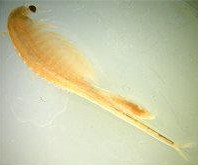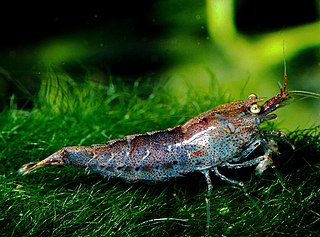
Anaspididae is a family of freshwater crustacean that is endemic to Tasmania, Australia. The family contains 3 genera and 5 species. This group of crustaceans are considered living fossils. They are commonly and collectively known as the Tasmanian anaspid crustaceans. Anaspidids have stalked eyes, long antennae and antennules, and a slender body with no carapace. The two species of Allanaspides and the single species of Paranaspides are all listed as vulnerable on the IUCN Red List.

Anaspides is a genus of freshwater crustaceans in the family Anaspidesidae. The genus was first described in 1894 by George Malcolm Thomson. The genus was originally placed in the family, Anaspididae by Thomson, but this genus name was preoccupied by the insect genus, Anaspis Geoffroy, 1762, and therefore, in 2017, the family was renamed Anaspidesidae by Shane Ahyong and Miguel A. Alonso-Zarazaga.

The Sunda flying fox or Sunda fruit bat is a species of bat in the family Pteropodidae. It is endemic to Indonesia. When it comes to conservation status for this species, The Sunda flying fox is in the vulnerable status, meaning this species has an Intermediate chance of becoming an endanger species by the deforestation of mangrove trees for shrimp aquaculture.

Linderiella occidentalis is a species of fairy shrimp native to California. It is a small crustacean in the family Chirocephalidae. It has a delicate elongated body, large stalked compound eyes, no carapace, and eleven pairs of swimming legs. It glides gracefully upside down, swimming by beating its legs in a complex, wavelike movement that passes from front to back. Like other fairy shrimp, L. occidentalis feeds on algae, bacteria, protozoa, rotifers and detritus.

The conservancy fairy shrimp is an endangered small crustacean in the family Branchinectidae. It ranges in size from about 1.25 centimetres (0.49 in) to 2.5 centimetres (0.98 in) long. This species is endemic to California in the United States.
Allanaspides helonomus is a species of mountain shrimp in the family Anaspididae.

Branchinecta is a genus of crustacean in family Branchinectidae. It includes around 50 species, found on all continents except Australia. Branchinecta gigas, the giant fairy shrimp, is the largest species in the order, with a length of up to 10 centimetres (4 in), and Branchinecta brushi lives at the highest altitude of any crustacean, at 5,930 metres (19,460 ft), a record it shares with the copepod Boeckella palustris. A new genus, Archaebranchinecta was established in 2011 for two species previously placed in Branchinecta.
Branchinecta longiantenna is a rare species of crustacean in the family Branchinectidae and the order Anostraca, the fairy shrimp. Its common name is longhorn fairy shrimp. It is endemic to California in the United States, where there are only four known populations. It is a federally listed endangered species of the United States.

The vernal pool fairy shrimp, Branchinecta lynchi, is a species of freshwater crustacean in the family Branchinectidae. It is endemic to the U.S. states of Oregon and California, living in vernal pools as well as non-vernal pool habitat. They range in size from 0.43 to 0.98 inches long. Vernal pool fairy shrimp are listed as a vulnerable species on the IUCN Red List, and has been listed as Federally Threatened species since 1994.
Branchinecta mexicana is a species of fairy shrimp in the family Branchinectidae. It is found in Central America.
Branchinella lithaca, the Stone Mountain fairy shrimp, is a species of crustacean in the family Thamnocephalidae. It was collected on Stone Mountain, De Kalb County, Georgia in 1940, and has not been seen since. It is listed as Critically Endangered on the IUCN Red List.
Parartemia contracta is a species of fairy shrimp in the family Parartemiidae and is commonly found in Australia.

Streptocephalus woottoni, with the common name Riverside fairy shrimp, is a rare species of crustacean in the family Streptocephalidae. It is native to Southern California in the United States, and northern Baja California in northwest Mexico.
Typhlatya iliffei is a species of basket shrimp in the family Atyidae, and was first described in 1981 by C.W. Hart Junior & Raymond B. Manning. It is found in the Caribbean.

Anaspidacea is an order of crustaceans, comprising eleven genera in four families. Species in the family Anaspididae vary from being strict stygobionts to species living in lakes, streams and moorland pools, and are found only in Tasmania. Koonungidae is found in Tasmania and the south-eastern part of the Australian mainland, where they live in the burrows made by crayfish and in caves. The families Psammaspididae and Stygocarididae are both restricted to caves, but Stygocarididae has a much wider distribution than the other families, with Parastygocaris having species in New Zealand and South America as well as Australia; two other genera in the family are endemic to South America, and one, Stygocarella, is endemic to New Zealand.

Macrobrachium carcinus is a species of fresh water shrimp known as the big claw river shrimp. It is native to streams, rivers and creeks from Florida to southern Brazil. It is the largest known species of Neotropical freshwater prawn, growing up to 30 centimetres (12 in) long and weighing as much as 850 grams (30 oz), although even larger specimens have been reported. It is an important species for commercial fishing in the Sao Francisco area, where it is known by the local name of pitu. M. carcinus is omnivorous, with a diet consisting of molluscs, small fish, algae, leaf litter and insects.

Anaspides tasmaniae is a species of fresh water crustacean of the family Anaspididae found in Tasmania. It is also known by the common names "mountain shrimp" or "chris' pseudo-mantis". It has been described as a "living fossil". A. tasmaniae lives in tarns and creeks over 300 metres above sea level, and is found in Lake St Clair and Clarence Lagoon.

Neocaridina palmata is a freshwater shrimp found in China and Vietnam. It is found in rivers, streams and ponds. Their preferred habitat is heavily planted, slow flowing water.
Anaspides clarkei is a species of freshwater crustacean in the family Anaspidesidae, and was first described in 2015 by Shane Ahyong
Anaspides jarmani is a species of freshwater crustacean in the family Anaspidesidae, and was first described in 2015 by Shane Ahyong











